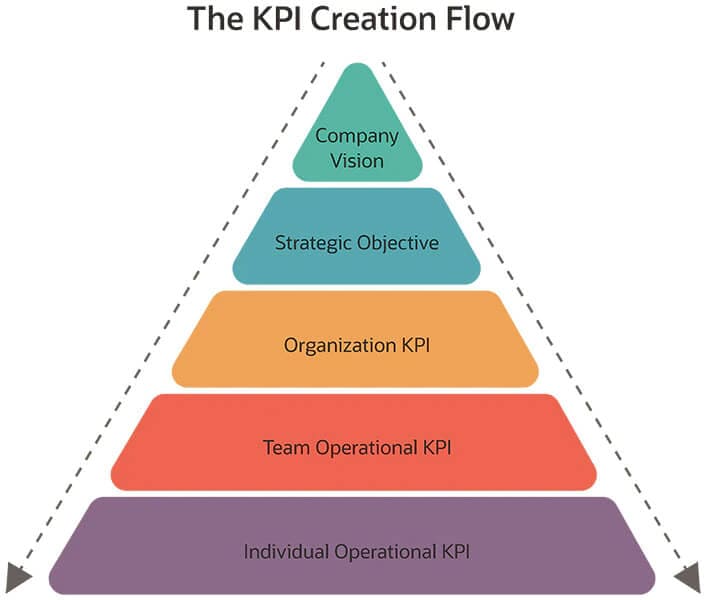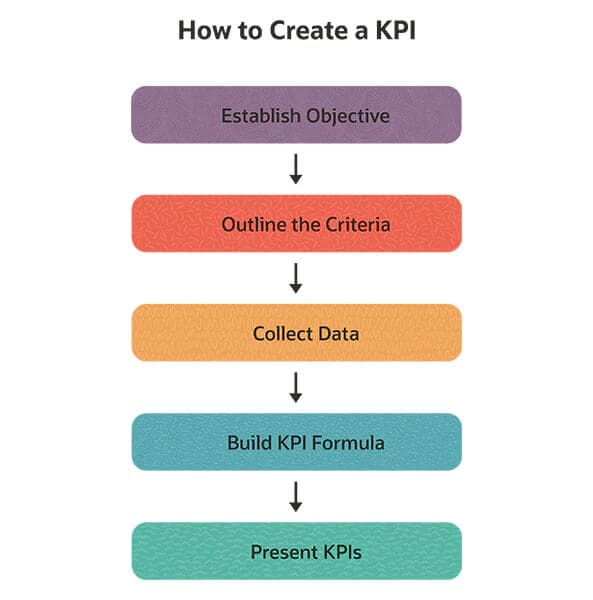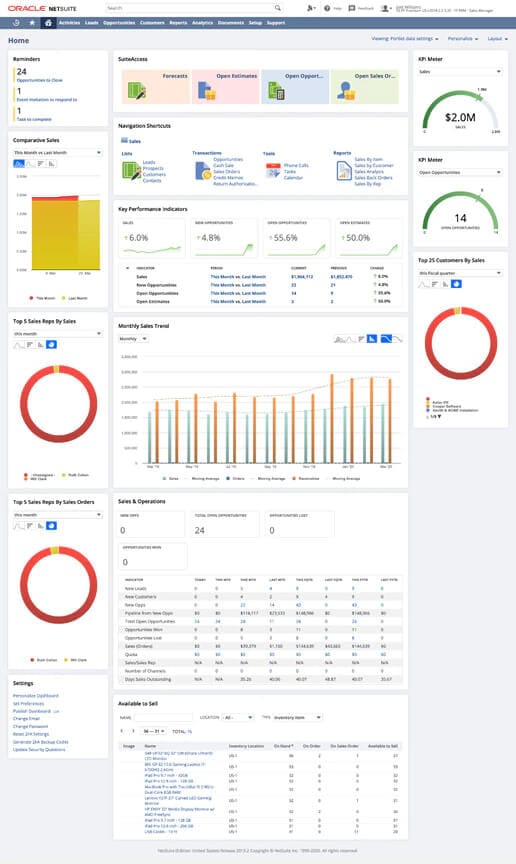Key performance indicators (KPIs) are important metrics that track a company’s progress toward achieving its strategic and operational goals. Monitoring KPIs over time helps organisations make better, data-driven decisions. Rewarding employees and teams for progress on KPIs that are aligned with company objectives can create a virtuous cycle that sets a company up for success.
This guide to KPIs provides comprehensive information about the different types of KPIs, how to choose them and how to use them. Whether you’re a C-suite executive or line-of-business manager, a customer-facing employee or working in the back office, there’s much to learn.
What Are Key Performance Indicators (KPIs)?
A KPI is a quantifiable measurement of progress toward a business goal. High-level KPIs reflect overall business operations. Lower-level KPIs report on a particular department or operation within a company, such as sales, marketing, inventory management or human resources. KPIs are calculated using data relevant to the targeted goal, such as a specific click-through rate on web ads for marketing or the number of sales closed per salesperson. Financial KPIs focus on metrics derived from accounting data, such as revenue growth and net cash flow. Examples of other KPIs include employee turnover and inventory carrying costs.
Key Takeaways
- KPIs are quantifiable measurements that gauge a company’s performance toward its goals.
- KPIs can be created at the strategic and operational organisational level, as well as for specific teams, projects and individuals.
- Best practices for selecting KPIs include alignment with business goals, active monitoring and accurate reporting and timelines.
- Automation of KPI reports and dashboards keeps all stakeholders aligned.
Key Performance Indicators (KPIs) Explained
Companies capture a lot of data, but not every metric is considered a KPI. The distinguishing characteristic of KPIs is that they measure performance toward a specific goal that’s critical to the business. For example, the amount of retail space square footage is an important metric, but monthly sales per square foot of retail space is a KPI.
By monitoring KPIs over time, organisations can track trends, highlight opportunities and identify potential trouble spots.
Why Are KPIs Important for Businesses?
KPIs are important management tools. They provide focus and clarity and guide behavior, productivity and decision making. KPIs also offer transparency and accountability. The way a company communicates its KPIs across the organisation conveys its mission and values and sets the tone for the work environment.
Therefore, it’s essential to select appropriate KPIs that align with the company’s goals. While a KPI can provide a useful snapshot at a specific point in time, KPIs are even more powerful when used to analyse progress over longer periods. Their value expands further when businesses consider them in combination with other meaningful KPIs in a dashboard, creating a more complete view of a company’s core operations.
Types of Key Performance Indicators (KPIs)
While there are many KPIs to choose from, most can be grouped into broad categories based on their purpose. One common method for categorising KPIs is the “balanced scorecard” framework of perspectives, which includes:
- Customer perspective or outcome focus: KPIs that focus on customer interactions and their views on product quality and performance. They may include customer satisfaction, acquisition and retention, brand awareness indexes or average handle time within a call center.
- Financial perspective: KPIs that examine profitability, liquidity, risk and financial efficiency. For example, days sales outstanding (DSO) and current ratio.
- Growth perspective: KPIs that measure returns on investment in equipment, research and staff to achieve the desired medium- and long-term growth. Return on marketing investment and customer acquisition cost are examples.
- Process perspective: KPIs that focus on the efficiency of specific processes. These can be units produced per hour in a manufacturing plant or billable hours in a professional services company.
Lastly, some KPIs can be project-specific. These typically measure progress toward milestones, dates or key deliverables.
What Are Leading and Lagging KPIs?
When analysing KPIs in any category, it’s important to consider whether they are a leading or lagging indicator. These filters provide context that can influence decision-making, especially regarding timing issues.
- Leading KPIs are predictive, pointing to possible future events or outcomes. They are useful for planning purposes. Take, for example, a sudden increase in the number of returned products. This might signal an issue with quality or expectations that were poorly communicated — and indicate that revenue will be lower going forward.
- Lagging KPIs measure what has already happened. They highlight patterns or trends over time. By monitoring those trends, companies can determine if they need to rework their plans. For example, if the KPI for inventory turnover has been decreasing over the past three quarters, the company may want to put a new go-to-market plan in place to reverse the trend.
It’s a best practice to consider a combination of leading and lagging KPIs for the same goal. Lagging indicators are more easily and accurately calculated, but are backward-looking. Leading indicators are often subject to interpretation but can provide time to change course if accurately interpreted.
What Are Organisational and Operational KPIs?
Another way to categorise KPIs is based on whether they are organisational or operational in nature. These categories are mutually exclusive but require precise alignment.
- Organisational KPIs measure strategic, long-term goals that are tied to a company’s mission or values. Examples include market share gains, customer acquisition increases, global expansion and revenue growth. Companies sometimes focus on a single all-important metric during each phase of a product’s life cycle, an approach known as one metric that matters (OMTM).
- Operational KPIs monitor day-to-day business performance in terms of tactical, operational processes and efficiency. Operational KPIs can be applied to processes, teams and individuals. Examples include sales by region and cost per click for a digital marketing campaign.
How Are KPIs Used?
KPIs are used to track progress toward a business goal. In practice, KPIs are created, communicated and then tracked over a period that coincides with the underlying objective.
Organisations typically analyse KPIs at intervals to determine whether course corrections are needed. They may reevaluate their choice of KPIs during this process. Some KPIs may be discontinued, revised or renewed once a goal has been reached. KPIs are often used for employee recognition, development and financial rewards.

How Many KPIs Do You Need?
There is no right answer to this question, though conventional wisdom suggests “less is more.” A selective approach helps keep the team focused on clear goals. Different teams will have unique KPIs aligned to their group’s goals. Most KPI dashboards display three to five KPIs for a given functional area, such as accounts payable KPIs.
When choosing KPIs to use for a particular goal, it’s helpful to have a mix of leading and lagging KPIs. Keep in mind that too many organisational KPIs can signal strategy confusion, and too many operational KPIs can spread effort thinly across competing targets.
KPI Best Practices
It can be challenging to select and manage the right KPIs for a business, and choosing incorrectly can be costly. Following industry standards can ease this risk somewhat, as can adherence to a few KPI best practices. These best KPI practices include:
- Aligning KPIs closely with the goals they are measuring.
- Ensuring the KPI is measurable in a specific, consistent and accurate way.
- Setting a KPI that’s attainable in a reasonably finite period of time.
- Choosing clear, relevant KPIs that encourage the right actions to achieve the goal.
- Challenging and re-evaluating the usefulness of the KPI for the purpose intended.
How to Create KPIs in 5 Steps
When creating KPIs, it’s important to “keep your eyes on the prize,” i.e. the specific goals you are aiming to achieve. Avoid mission creep and don’t go overboard. KPIs naturally flow out of an organisation’s vision and cascade through all levels in the organisation, ultimately creating individual KPIs for each employee. Follow these five steps for creating KPIs:
- Establish an objective. Clearly define the strategic objective or operational goal the KPI will measure.
- Outline the criteria. Identify the data that will be used for the KPI and ensure its integrity. Outline objective sources of information.
- Collect data. Establish how data will be collected and how often it will be updated.
- Build a KPI formula. Ideally, the KPI formula should be easy to understand and applied consistently.
- Present KPIs. Determine how to communicate and visually present the KPIs in dashboards or other tools. This should be done in a way that achieves buy-in from all stakeholders, especially those whose actions are critical to achieving the objective.

KPI Examples
Organisations have hundreds of KPIs at their disposal. Selecting the right ones depends on the goal being measured, the industry and the company. Typical examples of KPIs include:
- Sales
- Sales target: Compares new wins to targets or other periods.
- Sell-through rate: The percentage of available inventory sold during a given period.
- Sales conversion time: How long it takes for the sales team to convert the average lead into a sale.
- Financial
- Days sales outstanding (DSO): The average amount of time it takes to collect cash from sales made on credit.
- Gross profit margin: The percentage of revenue retained after deducting the direct costs of producing a product or delivering a service.
- Current ratio: Compares a company’s current assets to its current liabilities to measure its ability to meet short-term debts.
- Customer
- Customer lifetime value: How much revenue a company makes from each customer over the course of the business relationship.
- Customer churn rate: The percentage of active customers who stop purchasing in a set period of time.
- Call center pick-up rate: The percentage of customer calls that are answered within the first minute they are received.
- Operational
- Defective unit rate: Compares the number of defective units manufactured to the total number of units manufactured.
- Perfect order rate: A ratio of the number of error-free orders compared to the total number of orders processed.
- Marketing
- Incremental sales: Looks at additional revenue generated by marketing initiatives over baseline sales to determine the effectiveness of marketing campaigns.
- First-visit metric: Tracks how many first-time visitors come to a company’s website and their level of engagement during their first visit.
- Return on marketing investment (ROMI): Measures how much additional revenue a marketing campaign generates compared to its cost.
KPI Reporting and KPI Dashboards
KPIs should be monitored on a regular basis, using the most current information available. Automated reports and dashboards can replace the need for time-consuming manual processes.
- KPI reports: Recurring reports should include KPIs to facilitate continual analysis. Many software offerings let businesses customise reports, run them automatically at specified intervals and send them to key stakeholders.
- KPI dashboards: Graphic interfaces that display KPIs and other important information, are populated with real-time data. Customisation is key here, too. Dashboards can be customised for specific roles, like a CFO dashboard, departments or the organisation as a whole.
The following is an example of a sales manager’s dashboard. It shows four KPIs and KPI meters as well as other trends, graphs and tables of important information to help manage daily activities that will help the company reach its larger goals.

Free KPI Template
This free downloadable spreadsheet template takes you through each step of the KPI development process using the example of days sales outstanding, a typical accounts receivable KPI. The process begins with establishing objectives and source data. The template also includes an example formula and KPI graphic presentation.
Download the template to start building out and tracking your KPIs today.
Tracking KPIs With an ERP System
KPIs signal whether a company is on track to achieve its business goals, but companies that try to build and monitor KPIs manually often find the additional work very labor-intensive. This work can overshadow the analysis and decision-making part of the process. Further, reporting lag time can impair the company’s ability to act in a timely way.
A more effective approach to KPI management is via automation and integration with a company’s Enterprise Resource Planning (ERP) system that stores all the information the organisation would need to calculate any metric. ERP with built-in analytics that present data, charts and KPIs in dashboards and reports provide quick access to real-time, actionable KPIs.
KPIs provide an objective way to measure progress toward a company’s goals. They can be set at the strategic or organisational level and aligned with operational KPIs for teams and individuals. They help create a culture of accountability and data-driven decision-making. Integration with an ERP system can make KPI creation and tracking processes more efficient.
#1 Cloud ERP
Software
KPI FAQ
What is a KPI in simple terms?
A KPI, or key performance indicator, measures how successful a company is in meeting its targets, objectives or industry benchmarks.
What are the five key performance indicators?
Companies have numerous KPIs at their disposal. The ones they choose depend on their goals and operational processes. Some KPIs are used by a wide variety of companies in different industries, like operating and net profit margin, sales growth and accounts receivable turnover. Companies also choose industry-specific KPIs. For example, manufacturers may track KPIs that measure how quickly and efficiently they convert their investment in fixed assets and inventory into cash.
What are some examples of KPIs?
Organisational KPIs measure strategic goals, like global expansion. Operational KPIs track day-to-day business activities. Examples of organisational KPIs are revenue growth or the cost and rate of customer acquisition. Examples of operational KPIs include days sales outstanding and defective unit rate.
What is a KPI and why is it important?
A KPI measures a company’s progress toward a set of objectives. Tracked over a set period of time, KPIs help an organisation make better, data-driven decisions. They also can guide behavior, productivity and decision-making, and provide transparency and accountability.









